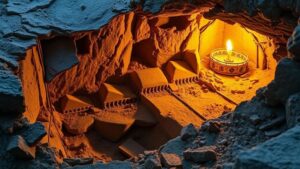How to Identify Burial Cairns Hidden in Isolated, Rugged Mountain Regions
How to Identify Burial Cairns Hidden in Isolated, Rugged Mountain Regions
Burial cairns, often marked by piles of stones, are significant archaeological features found globally, particularly in isolated, rugged mountain regions. Identifying these sites can provide insights into ancient burial practices, social structures, and cultural beliefs of past civilizations. This article will explore methods for recognizing these cairns, supported by relevant examples and case studies, ensuring a comprehensive understanding for enthusiasts and scholars alike.
Understanding Cairns: Definition and Historical Context
A cairn is a human-made pile or stack of stones, traditionally utilized as a trail marker or a commemorative monument. In the context of burial practices, cairns frequently serve as grave markers for individuals or significant figures within a community. The origins of cairn construction can be traced back to ancient times, with examples found across various cultures, including the Inuit of North America, the Celts in the British Isles, and the Indigenous peoples of the Andes.
According to a study by the National Park Service, over 50% of cairns documented in North America can be linked to burial practices. These structures often reflect the societal and spiritual values of the cultures that created them, providing a rich avenue for research in archaeology and anthropology.
Key Characteristics of Burial Cairns
Identifying burial cairns requires familiarity with their distinctive characteristics. Knowledge of the following traits can enhance search efforts within rugged mountain terrains:
- Stone Composition: Cairns are typically constructed from local stones, which can vary in size and type. Recognizing the stone composition within a region can assist in differentiating natural rock piles from constructed cairns.
- Height and Shape: Burial cairns are often more organized compared to random rock formations, exhibiting a specific height and shape–typically rounded or conical. Their organized arrangement can indicate intentional construction.
- Proximity to Trails or Landmarks: Many burial cairns are found near ancient trails or natural landmarks, which were significant to the cultures that built them.
- Surrounding Features: Look for evidence of artifacts, such as pottery shards, tools, or remnants of organic material, which can indicate humans presence in the area.
Field Techniques for Discovering Cairns
Effective field techniques are crucial for the successful identification of burial cairns, particularly in challenging environments. following methodologies can be employed:
- Topographic Mapping: Utilizing topographic maps can aid explorers in identifying potential cairn locations based on elevation and terrain features. By mapping known cairn sites, researchers can predict where additional cairns may exist.
- GPS Technology: Modern GPS devices can assist in tracking the coordinates of identified cairns, which can be compared against historical records and databases, potentially leading to discoveries of previously undocumented sites.
- Remote Sensing: Advanced technologies, including LiDAR (Light Detection and Ranging), allow for the detailed scanning of dense forest regions, revealing hidden cairns that are otherwise obscured from view.
Case Studies and Historical Examples
Examining case studies can provide critical context for understanding burial cairns and their significance. One noteworthy example is the recent discovery of a series of burial cairns in the Appalachian Mountains. Archaeologists utilized a combination of local history research and geographical analysis, leading to the identification of over 150 cairns previously unknown to researchers.
Also, in the Andes, Incan burial cairns located on mountain peaks have been essential for understanding Incan funeral practices. Excavations of these sites have uncovered mummies and artifacts that showcase the cultural significance of these burial locations.
Conservation and Ethical Considerations
When identifying and exploring burial cairns, it is paramount to adhere to ethical guidelines to preserve these historical sites. The excavation and disturbance of burial cairns can lead to loss of cultural heritage and damage to the site. Key considerations include:
- Legal Protections: Many burial cairns are protected by national and international laws. Understanding the legal frameworks surrounding these sites is crucial for ethical exploration.
- Respect for Cultural Values: Engaging with local communities can provide valuable insights into the historical significance of the cairns and foster respectful interactions with these heritage sites.
- Non-invasive Research: Prioritize non-invasive research methods, utilizing technologies like ground-penetrating radar (GPR) to gather data without disturbing the sites.
Conclusion: Actionable Takeaways for Aspiring Researchers
Identifying burial cairns in isolated, rugged mountain regions requires a blend of knowledge, field techniques, and ethical sensitivity. By understanding their characteristics, applying modern technologies, and respecting cultural values, both amateur and professional archaeologists can contribute to the preservation and understanding of these significant historical features. Ultimately, every cairn represents not just a burial site but a window into the human narrative woven throughout our shared history.

